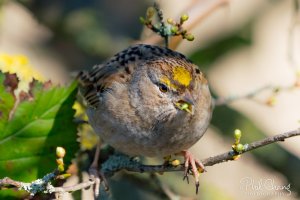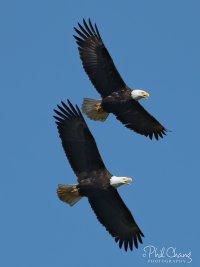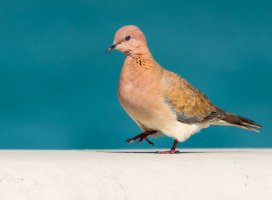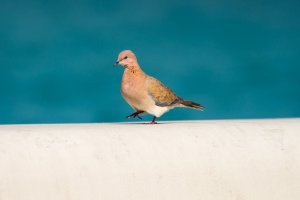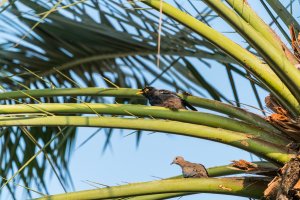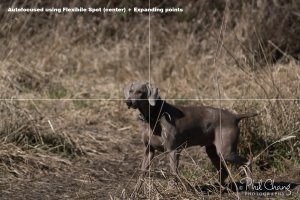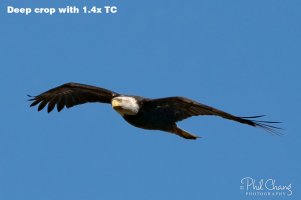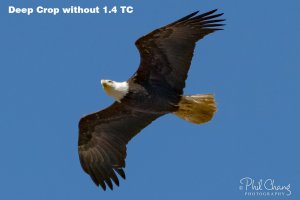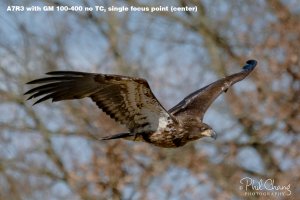You are using an out of date browser. It may not display this or other websites correctly.
You should upgrade or use an alternative browser.
You should upgrade or use an alternative browser.
Canon 100-400 L II vs Sony 100-400 GM OSS
- Thread starter Talys
- Start date
Talys said:I've been fortunate enough to have a friend's Sony A7R3 and 100-400 4.5-5.6 GM OSS for a little while. I've been playing around with the lens, and thought I would share my first impressions of it in comparison to the 100-400 L II, which I own.
I use 7D2 with 100-400 Mark II for birds much as you do (passerines, not so much BIF). However I also use it a lot for insects, especially dragonflies/damselflies. At MFD, photos from this combo can be incredibly detailed.
Can your or anybody else here post insect photos taken with the Sony combo? Or the Sony with the Canon 100-400?
Upvote
0
JBSF said:Talys said:I've been fortunate enough to have a friend's Sony A7R3 and 100-400 4.5-5.6 GM OSS for a little while. I've been playing around with the lens, and thought I would share my first impressions of it in comparison to the 100-400 L II, which I own.
I use 7D2 with 100-400 Mark II for birds much as you do (passerines, not so much BIF). However I also use it a lot for insects, especially dragonflies/damselflies. At MFD, photos from this combo can be incredibly detailed.
Can your or anybody else here post insect photos taken with the Sony combo? Or the Sony with the Canon 100-400?
I would happily take some, but it's not quite insect season yet. I've not yet seen dragonflies where I normally do.
I agree: the Canon 100-400LII takes amazing MFD bug photos.
Upvote
0
JBSF said:Can your or anybody else here post insect photos taken with the Sony combo? Or the Sony with the Canon 100-400?
At 100mm or 400mm?
It's a rainy, cloudy day and I don't know if I can find any photogenic insects, but will if I do.
Sun came out, but no insects readily posing. Here's a decollate snail at 400mm, roughly minimum focus distance, though shot handheld with AF, so focus isn't as good as it chould be.
Full size and then big crop with some editing.
Attachments
Upvote
0
Well, after a couple more hours of shooting the Sony, I have to say that my biggest complaint about it - by FAR - is the focus by wire.
This is a really major problem for me for birds in flight that may be insurmountable. I'm not sure. What happens is that the bird is quite far away, but my last subject was a portrait at a different distance. On a 100-400L2, I can simply turn the MF ring and get at least to the point where I can see the bird -- which takes a fraction of a second -- and then let AF lock on. My success rate for big birds (which are, of course, slower), is very high.
With the GMaster, what happens is that by the time the AF finds its way to the 30m or 40m, the bird is (long) gone. It must have happened to me 10+ times today. A potential solution may be to map the AF/MF button to the little button at the end of the lens, MF, and then switch it back to AF. But that sounds like such a stupid solution.
Also, subject tracking while panning is excellent, but when the subject is moving towards me, the number of in-focus shots is quite low, especially if I qualify that to wanting the head of the bird in focus. When photographing eagles, out of 8 shots, there'd be 1 with the head in focus, and a half dozen where the head/eyes are soft.
As a bird portrait lens, and using the "+" autofocus magnify tip from Neutral, the camera/lens setup is magnificent. The downside to this is that to get out of single-shot autofocus and back into continuous autofocus for BIF is cumbersome -- it's a 2-step procedure that is several button presses.
Finally -- my solution to the camera's apparently crappy AE (at least with the GMaster 100-400) has been to manually set +/- EV using the thumb dial. Shooting outdoors in good sunlight -- it is a bit mind-boggling to me how far off the AE can be.
This is a really major problem for me for birds in flight that may be insurmountable. I'm not sure. What happens is that the bird is quite far away, but my last subject was a portrait at a different distance. On a 100-400L2, I can simply turn the MF ring and get at least to the point where I can see the bird -- which takes a fraction of a second -- and then let AF lock on. My success rate for big birds (which are, of course, slower), is very high.
With the GMaster, what happens is that by the time the AF finds its way to the 30m or 40m, the bird is (long) gone. It must have happened to me 10+ times today. A potential solution may be to map the AF/MF button to the little button at the end of the lens, MF, and then switch it back to AF. But that sounds like such a stupid solution.
Also, subject tracking while panning is excellent, but when the subject is moving towards me, the number of in-focus shots is quite low, especially if I qualify that to wanting the head of the bird in focus. When photographing eagles, out of 8 shots, there'd be 1 with the head in focus, and a half dozen where the head/eyes are soft.
As a bird portrait lens, and using the "+" autofocus magnify tip from Neutral, the camera/lens setup is magnificent. The downside to this is that to get out of single-shot autofocus and back into continuous autofocus for BIF is cumbersome -- it's a 2-step procedure that is several button presses.
Finally -- my solution to the camera's apparently crappy AE (at least with the GMaster 100-400) has been to manually set +/- EV using the thumb dial. Shooting outdoors in good sunlight -- it is a bit mind-boggling to me how far off the AE can be.
Upvote
0
Phil
Thanks so much for relaying your insights and experience. It has been most useful for me and I am sure many others. I threw my 5DSR + 100-400mm II into the car on Saturday as I thought I might have had some shooting opportunities yesterday on the way back from an event. The combination behaved flawlessly for BIFs I cam across, and the 5DSR is not the best Canon for BIF. The 100-400 II is such a reliable lens.
Alan
Thanks so much for relaying your insights and experience. It has been most useful for me and I am sure many others. I threw my 5DSR + 100-400mm II into the car on Saturday as I thought I might have had some shooting opportunities yesterday on the way back from an event. The combination behaved flawlessly for BIFs I cam across, and the 5DSR is not the best Canon for BIF. The 100-400 II is such a reliable lens.
Alan
Upvote
0
Talys said:Also, subject tracking while panning is excellent, but when the subject is moving towards me, the number of in-focus shots is quite low, especially if I qualify that to wanting the head of the bird in focus. When photographing eagles, out of 8 shots, there'd be 1 with the head in focus, and a half dozen where the head/eyes are soft.
For better a7r3 AF tracking for BIF you might try to increase AF Track sensitivity from standard 3 to 5 and change AF-C priority from default settings to AF.
Here is AF guide for a9 which is applicable to a7r3.
http://support.d-imaging.sony.co.jp/www/support/ilc/focus/en/a9/settings/index.html
But I would not expect the same AF performance for a7r3 as for a9, which I think is the only one Sony FF camera which tracking AF capabilities are on par with DSLRs with dedicated AF sensor.
A9 is doing AF sampling and recalculations at 60Hz but for a7r3, I did not find any information.
Probably for 10FPS tracking a7r3 should be doing at least twice more so AF sampling rate could be up to 20HZ though I have some doubts that is so high.
If you have bird not far from you approaching you at 60km/h this is about 17 m/sec advance per second.
So for a9 with 60Hz AF every object will be moving about 0.27m between samples so it is easy for a9 to track and predict object position and keep it within lens DOF.
If we assume that a7r3 has 20Hz AF sampling then tracked bird distance change between AF samples would be around 0.83m so approaching bird could get out of DOF range easily, especially if bird is close to camera.
So I would not expect a7r3 to be on par with a9 as well as with any modern DSLRs which have dedicated high speed AF sensor. Only a9 is real competitor at the moment, and this performs for BIFs perfectly, much better than a7r3 , on par with 1DXm2.
Upvote
0
And Canon 100-400 II with 2x III extender has better optical quality than 100-400 GM with Sony 2x extenderAlanF said:Phil
Thanks so much for relaying your insights and experience. It has been most useful for me and I am sure many others. I threw my 5DSR + 100-400mm II into the car on Saturday as I thought I might have had some shooting opportunities yesterday on the way back from an event. The combination behaved flawlessly for BIFs I cam across, and the 5DSR is not the best Canon for BIF. The 100-400 II is such a reliable lens.
Alan
Sony 1.4 extender does not have noticable impact for image quality but for 2x it is very noticable so need to be used only when there is no other choice.
As I already mentioned for BIF shooting, especiallty if they approching fast along lens direction, any modern DSLs are still better than any Sony cameras except for a9 which is specially designed for high AF performance and high tracking speed, but this is not within reach for many people , though still cheaper than 1Dxm2.
Upvote
0
AlanF said:Phil
Thanks so much for relaying your insights and experience. It has been most useful for me and I am sure many others. I threw my 5DSR + 100-400mm II into the car on Saturday as I thought I might have had some shooting opportunities yesterday on the way back from an event. The combination behaved flawlessly for BIFs I cam across, and the 5DSR is not the best Canon for BIF. The 100-400 II is such a reliable lens.
Alan
Thanks, Alan.
I should mention one other ergonomic detail that is extremely irritating on the GMaster 100-400. Unlike the newer Canon focus-by-wire lenses (like 70-300 II and 18-135 nano), the GM manual focus ring does not accelerate very much. While I didn't particularly like the feature on the Canon lenses in comparison to mechanical USM, at least you could quickly go from near to infinity.
On the Sony, it is impossible to get from near to infinity with a single action. It seems that no matter how fast you twist it, the GMaster takes 1 full rotation to do that, and it's obviously not possible to do this without letting go and twisting again. In practice, it takes a good 3 solid twists if I really want to go from one end to the other.
The lack of a distance scale on the top hurts it in this respect too. On my 100-400LII, I subconsciously check the distance scale when I'm not using the camera to set it to a closer range of my next, anticipated BIF shot so that I can see a bird through the viewfinder, if it it's blurry, and so that AF locks quickly.
Neutral said:For better a7r3 AF tracking for BIF you might try to increase AF Track sensitivity from standard 3 to 5 and change AF-C priority from default settings to AF.
Here is AF guide for a9 which is applicable to a7r3.
http://support.d-imaging.sony.co.jp/www/support/ilc/focus/en/a9/settings/index.html
But I would not expect the same AF performance for a7r3 as for a9, which I think is the only one Sony FF camera which tracking AF capabilities are on par with DSLRs with dedicated AF sensor.
A9 is doing AF sampling and recalculations at 60Hz but for a7r3, I did not find any information.
Probably for 10FPS tracking a7r3 should be doing at least twice more so AF sampling rate could be up to 20HZ though I have some doubts that is so high.
If you have bird not far from you approaching you at 60km/h this is about 17 m/sec advance per second.
So for a9 with 60Hz AF every object will be moving about 0.27m between samples so it is easy for a9 to track and predict object position and keep it within lens DOF.
If we assume that a7r3 has 20Hz AF sampling then tracked bird distance change between AF samples would be around 0.83m so approaching bird could get out of DOF range easily, especially if bird is close to camera.
So I would not expect a7r3 to be on par with a9 as well as with any modern DSLRs which have dedicated high speed AF sensor. Only a9 is real competitor at the moment, and this performs for BIFs perfectly, much better than a7r3 , on par with 1DXm2.
Thanks, Neutral. Your advice has been very helpful; I really appreciate it. I will give some of your other suggestions a try while I have this beast. It has definitely been an enjoyable experience, unlike the A7RII, which was very frustrating for birding.
It's worth mentioning that you can't really get 10fps in a useful sense out of the A7R3. 10fps is only possible in Hi+ drive mode, and according to Sony, unlike the A9, the A7R3 has a delayed viewfinder image with Hi+ -- making it not possible to track the subject.
So, Hi+ remains useful, for example, with a diver, or if you want to capture a bird taking off (I suppose), but generally, the 8fps "Hi" speed will be the fastest desired setting for BIF.
By the way, I'm not comparing the AF on the A7R3 to a 5D4; although I've used one before, my main camera is a 6D Mark II, and the AF tracking for a large bird flying towards me (like a eagle at a height of about 6-10 meters) is so far markedly better.
Upvote
0
Thanks. Good point. I meant at 400mm. The photo you provided is extremely similar to what I get with 7D2 and 100-400 mark II. The tiny flecks at the sharpest point of focus are what I would hope to see, and it appears that a crop from the full frame Sony is about equal to what I get on the APS-C Canon. I sometimes back off to about 350mm, but more often to increase depth of focus than to get a sharper image. In fact, I'm not convinced that my copy is less sharp at 400mm than it is at 350mm. I think one of the greatest strengths of the 100-400 mark II is the IS, which is fantastic for handheld photos like this.
Upvote
0
Well, I used the 1.4TC yesterday, so some comments there:
1. The size is excellent, extending the camera by just 16mm (compared to 26mm on the Canon 1.4 IIII).
2. It is a very important piece of the puzzle for Sony for now, because native lens options essentially end with it at 560mm/f8. The 2x is not a real option on the camera, because autofocus past f/8 is not PDAF.
3. Good news for Sony: The TC on the 100-400 GM has a smaller hit to autofocus speed than the Canon 100-400LII + 1.4 III.
4. Bad news for Sony: like the 100 - 400LII + 1.4 III, it's a pretty terrible Bird in Flight combination in terms of autofocus speed. But then again, the Canon combination isn't very good for birds in flight either -- not so much tracking the bird, but getting the initial AF lock, if you only have a couple of seconds and you aren't already focused on or near the vicinity of the bird.
5. The only way I could get it to autofocus was to AF on some trees at about the same distance at a lower zoom, then point it at the bird, and then letting it do its thing. Then, following the bird (using a small zone AF, like center + expanding).
6. I photographed 105 shots of two eagles circling in the air. I was very lucky: they circled for a long time. If you've ever shot eagles, when they do this, it's very easy to focus on them, because their flight pattern is relatively slow and predictable. Exposure setting was something like 1/2000, f/8, ISO 320. I was using a monopod with a sirui tilt head.
Literally ONE was in "best" focus, which wasn't really perfect, but was probably as good as I'd get with AF. TWO were very close after artificial sharpening. FOUR more were close enough to be considered good focus after artificial sharpening. 98/105 shots were garbage.
For reference, on a 6DII, my shot percentage would have been something like 60%+ in perfect focus, with or without an extender.
7. For bird portraits in a situation where the extra 40% reach lets you take a well-composed shot where the subject fills up the frame, it's excellent. In my opinion, better than the Canon, because you can focus magnify, manually adjust, and guarantee a perfect focus on the eye much easier than you can on the Canon.
8. Whites against contrast solids had CA that don't correct in post (without manually photoshoping it). Slightly OOF whites had bad CA, worse than without the extender. It is also small enough that if your subject fills up the frame and you can resample that image down to typical distribution sizes from the original 42mp, it will disappear.
9. IQ was generally pretty good, but it definitely suffers a little. If I could split the difference and get 20% closer to the subject, I would rather do that than to use take the extender, with the 40% magnification. This, based on some heron shots (though the extender shots were in a different location as the non-extender shots). Note that this is no different than the Canon.
Attached is the best shot I could get out of 105. It was photographed using uncompressed RAW (so, 85MB file), 1/2000, f/8, ISO 320. It is cropped, but not resized, and sharpened as best I could in LR.
This image has a long edge of about 1800 pixels, so it's not exactly a deep crop, though it's still a significant one. That said, I am able to get very good 1500-2000 pixel bird crops out of a 6DII with the 100-400LII with or without the extender, definitely superior to this one. But I will try some more, and report back.
1. The size is excellent, extending the camera by just 16mm (compared to 26mm on the Canon 1.4 IIII).
2. It is a very important piece of the puzzle for Sony for now, because native lens options essentially end with it at 560mm/f8. The 2x is not a real option on the camera, because autofocus past f/8 is not PDAF.
3. Good news for Sony: The TC on the 100-400 GM has a smaller hit to autofocus speed than the Canon 100-400LII + 1.4 III.
4. Bad news for Sony: like the 100 - 400LII + 1.4 III, it's a pretty terrible Bird in Flight combination in terms of autofocus speed. But then again, the Canon combination isn't very good for birds in flight either -- not so much tracking the bird, but getting the initial AF lock, if you only have a couple of seconds and you aren't already focused on or near the vicinity of the bird.
5. The only way I could get it to autofocus was to AF on some trees at about the same distance at a lower zoom, then point it at the bird, and then letting it do its thing. Then, following the bird (using a small zone AF, like center + expanding).
6. I photographed 105 shots of two eagles circling in the air. I was very lucky: they circled for a long time. If you've ever shot eagles, when they do this, it's very easy to focus on them, because their flight pattern is relatively slow and predictable. Exposure setting was something like 1/2000, f/8, ISO 320. I was using a monopod with a sirui tilt head.
Literally ONE was in "best" focus, which wasn't really perfect, but was probably as good as I'd get with AF. TWO were very close after artificial sharpening. FOUR more were close enough to be considered good focus after artificial sharpening. 98/105 shots were garbage.
For reference, on a 6DII, my shot percentage would have been something like 60%+ in perfect focus, with or without an extender.
7. For bird portraits in a situation where the extra 40% reach lets you take a well-composed shot where the subject fills up the frame, it's excellent. In my opinion, better than the Canon, because you can focus magnify, manually adjust, and guarantee a perfect focus on the eye much easier than you can on the Canon.
8. Whites against contrast solids had CA that don't correct in post (without manually photoshoping it). Slightly OOF whites had bad CA, worse than without the extender. It is also small enough that if your subject fills up the frame and you can resample that image down to typical distribution sizes from the original 42mp, it will disappear.
9. IQ was generally pretty good, but it definitely suffers a little. If I could split the difference and get 20% closer to the subject, I would rather do that than to use take the extender, with the 40% magnification. This, based on some heron shots (though the extender shots were in a different location as the non-extender shots). Note that this is no different than the Canon.
Attached is the best shot I could get out of 105. It was photographed using uncompressed RAW (so, 85MB file), 1/2000, f/8, ISO 320. It is cropped, but not resized, and sharpened as best I could in LR.
This image has a long edge of about 1800 pixels, so it's not exactly a deep crop, though it's still a significant one. That said, I am able to get very good 1500-2000 pixel bird crops out of a 6DII with the 100-400LII with or without the extender, definitely superior to this one. But I will try some more, and report back.
Attachments
Upvote
0
AlanF said:Phil, thanks for more testing. To my eyes, both eagles are very soft, and they are over-sharpened. I can do better than that with a Canon 100-400mm II + TC.
I couldn't agree more, on both points. I'd have deleted them had they come out of my 6DII.
The autofocus for birds in focus is simply a waste of time, except for the very specific circumstance where the bird starts stationary (eg perched), and takes flight laterally where the AF doesn't need to adjust.
I took about 1,000 more BIF photos today, mostly with the TC, and a few without; With the TC, it was awful. Without, it actually went pretty well. I'll post up some of the shots when I get a chance.
With the TC, I was able to get some great photos of larger subjects, like dogs -- so, I suspect, it is an acceptable wildlife lens combination, just not for small, moving subjects, like birds.
Upvote
0
Thanks for sharing test results.Talys said:Well, I used the 1.4TC yesterday, so some comments there:
1. The size is excellent, extending the camera by just 16mm (compared to 26mm on the Canon 1.4 IIII).
2. It is a very important piece of the puzzle for Sony for now, because native lens options essentially end with it at 560mm/f8. The 2x is not a real option on the camera, because autofocus past f/8 is not PDAF.
3. Good news for Sony: The TC on the 100-400 GM has a smaller hit to autofocus speed than the Canon 100-400LII + 1.4 III.
4. Bad news for Sony: like the 100 - 400LII + 1.4 III, it's a pretty terrible Bird in Flight combination in terms of autofocus speed. But then again, the Canon combination isn't very good for birds in flight either -- not so much tracking the bird, but getting the initial AF lock, if you only have a couple of seconds and you aren't already focused on or near the vicinity of the bird.
5. The only way I could get it to autofocus was to AF on some trees at about the same distance at a lower zoom, then point it at the bird, and then letting it do its thing. Then, following the bird (using a small zone AF, like center + expanding).
6. I photographed 105 shots of two eagles circling in the air. I was very lucky: they circled for a long time. If you've ever shot eagles, when they do this, it's very easy to focus on them, because their flight pattern is relatively slow and predictable. Exposure setting was something like 1/2000, f/8, ISO 320. I was using a monopod with a sirui tilt head.
Literally ONE was in "best" focus, which wasn't really perfect, but was probably as good as I'd get with AF. TWO were very close after artificial sharpening. FOUR more were close enough to be considered good focus after artificial sharpening. 98/105 shots were garbage.
For reference, on a 6DII, my shot percentage would have been something like 60%+ in perfect focus, with or without an extender.
7. For bird portraits in a situation where the extra 40% reach lets you take a well-composed shot where the subject fills up the frame, it's excellent. In my opinion, better than the Canon, because you can focus magnify, manually adjust, and guarantee a perfect focus on the eye much easier than you can on the Canon.
8. Whites against contrast solids had CA that don't correct in post (without manually photoshoping it). Slightly OOF whites had bad CA, worse than without the extender. It is also small enough that if your subject fills up the frame and you can resample that image down to typical distribution sizes from the original 42mp, it will disappear.
9. IQ was generally pretty good, but it definitely suffers a little. If I could split the difference and get 20% closer to the subject, I would rather do that than to use take the extender, with the 40% magnification. This, based on some heron shots (though the extender shots were in a different location as the non-extender shots). Note that this is no different than the Canon.
Attached is the best shot I could get out of 105. It was photographed using uncompressed RAW (so, 85MB file), 1/2000, f/8, ISO 320. It is cropped, but not resized, and sharpened as best I could in LR.
This image has a long edge of about 1800 pixels, so it's not exactly a deep crop, though it's still a significant one. That said, I am able to get very good 1500-2000 pixel bird crops out of a 6DII with the 100-400LII with or without the extender, definitely superior to this one. But I will try some more, and report back.
As I mentioned earlier, to my opinion, the only one Sony camera that could be used for BIF with long tele lenses is A9.
I am not birds shooter but i did some tests using 100-400GM and a9 and results are excellent for BIF, practically every shot in focus. For a7r3 this is different, many shots are soft.
One missing feature for a9 and a7r3 as well for other mirrorless brands is ability to register focus distance preset in camera. This is very irritating when you can not set focus to infinity instantly.
Using such feature AF preset could be assigned to any button ( e.g. on focus lock button on lens ) giving ability to set requied focus distance instantly. Register focus to infinity and then by single press of button you are there.
This would be very useful for any mirrorless cameras, not only for Sony but also for Canon when working in live view. Also this could be extreemly useful for sports shooters.
If Canon does that for their future mirrorless then they could have some advantage over other brands. And do not forget to pay me royalty fees for advice if they do that
Upvote
0
Thanks Talys and Neutral for removing any GAS I had for the Sony. I am always on the hunt for better gear. Last time, I bought on-line the A7RII because of the rave reviews, and sent it back after two days as the SF wasn't good enough with Metabones and other factors. The reviews on the A7RIII then said that it was the camera the A7RII should have been, with better AF etc. It's so easy to be swayed into buying, and you you can't trust reviewers so it is just so helpful when Forum members give their real and honest experience
I was looking seriously at the Panasonic G9 as it had such rave reviews and the new Elmarit 200mm f/2.8 is a stunning lens. But, thinking about it, you realise it has not much better resolution than a 5DSR and hardly any more than a 24 mpx Canon APS-C. Then, you start seeing seeing the odd throwaway line in otherwise rave reviews: "you can't expect Canon AF"; "The lens does hunt rather too much" etc. Only Nikon could tempt me away for bird photography, but they don't have a 100-400mm II or a 400mm DO II, so Canon, you have me hooked, as the 200-500mm is heavy and not as good as my Canons for BIF, and nothing compares with the DO.
I was looking seriously at the Panasonic G9 as it had such rave reviews and the new Elmarit 200mm f/2.8 is a stunning lens. But, thinking about it, you realise it has not much better resolution than a 5DSR and hardly any more than a 24 mpx Canon APS-C. Then, you start seeing seeing the odd throwaway line in otherwise rave reviews: "you can't expect Canon AF"; "The lens does hunt rather too much" etc. Only Nikon could tempt me away for bird photography, but they don't have a 100-400mm II or a 400mm DO II, so Canon, you have me hooked, as the 200-500mm is heavy and not as good as my Canons for BIF, and nothing compares with the DO.
Upvote
0
Attached is FE100-400 with 1.4x extender on Sony a7r2 , full frame and 100% crop.
560mm ,1/1000sec, f8, ISO1000
Also earlier shots ,a7r2 with Canon 100-400 with 1.4x III extender using Matabones IV adapter, I posted it here some time back
Also at 560mm, camera was in crop APC mode to cut off not required from frame.
Both Canon and Sony 100-400 with 1.4x extenders are top-notch performers.
560mm ,1/1000sec, f8, ISO1000
Also earlier shots ,a7r2 with Canon 100-400 with 1.4x III extender using Matabones IV adapter, I posted it here some time back
Also at 560mm, camera was in crop APC mode to cut off not required from frame.
Both Canon and Sony 100-400 with 1.4x extenders are top-notch performers.
Attachments
Upvote
0
I have some additional photos that are better, and that describe some of the problems with the camera for me, personally.
1. First of all, in the first photo, I used center point + expanding points on the dog. I've highlighted the center; yet you can see how the AF picked up the grass. There's really no excuse for this. It's much worse for bird portraits, because a stray leaf that you can't see will grab autofocus if it's closer to the camera.
2. Here is the best deep crop with teleconverter that I could get with the TC. Note that I took over 1,000 photos that day, and the vast majority (like 99%) were garbage. The shadows on this photo were not recoverable without adding unwanted artifacts.
3. Deep crop without the TC - this one is actually pretty good, I think. My ratio of in-focus shots without the TC went up dramatically without the TC, and using center point only. The only problem is that it's hard to know WHERE to focus, because 90% of the time, I couldn't see anything at all, and without a distance scale or a way to manually rotate focus, all I could see in blue sky was, well, unfocused blue. I ended up AF on trees at approximately the distance, then spot the bird. The problem is, if the center spot wasn't right on the bird, BOOM. Blurry blue, again with no bird, and no way to find it. This is just not an issue with Canon.
Setting the AF range to 3m-infinity definitely helps, and I'm rarely getting within 3m of any subject anyways when birding.
4. But all is not lost - with single focus point, it is possible to get some relatively good shots, even with a busy background. It works with center + expanding, too, as long as NOTHING will get in front of the bird.
I give up on the subject tracking. Yes, it looks so nice to see in the viewfinder that my bird is being tracked by the camera. It's so impressive that it can be anywhere in the VF, and apparently in focus. There's a green box around it right? I can lock on the bird somewhere in the VF, and it tracks as the bird flies towards me and blow that beautiful buffer... that's 16 uncompressed frames at 42 megapixels, with a nice, juicy one at the end that's tons of pixels wide of bird!! Buuuuuut... when I check... most of the time, the first or second frame looks pretty good, and the next 14 are all OOF unless it's a panning shot, where focus barely changes anyways. Maybe not horribly OOF, but not good enough to keep.
That's using the 8fps drive speed that Sony recommends (instead of 10).
My general impression is: the TC is a no-go for birds in flight, and adapted lenses just don't focus quickly enough. So if you want > 400mm for BIFs, the Sony A7R3 isn't the right choice.
Without the TC, it's tolerable. It is a compromise, because you can get gorgeous bird portraits, that are perfectly focused on every shot. But at least for me (and I'll concede that I'm sure I'd get better if I stuck with it), I'd have to give up a decent chunk of in-flight photos, which are much more exciting when I do get to capture them.
1. First of all, in the first photo, I used center point + expanding points on the dog. I've highlighted the center; yet you can see how the AF picked up the grass. There's really no excuse for this. It's much worse for bird portraits, because a stray leaf that you can't see will grab autofocus if it's closer to the camera.
2. Here is the best deep crop with teleconverter that I could get with the TC. Note that I took over 1,000 photos that day, and the vast majority (like 99%) were garbage. The shadows on this photo were not recoverable without adding unwanted artifacts.
3. Deep crop without the TC - this one is actually pretty good, I think. My ratio of in-focus shots without the TC went up dramatically without the TC, and using center point only. The only problem is that it's hard to know WHERE to focus, because 90% of the time, I couldn't see anything at all, and without a distance scale or a way to manually rotate focus, all I could see in blue sky was, well, unfocused blue. I ended up AF on trees at approximately the distance, then spot the bird. The problem is, if the center spot wasn't right on the bird, BOOM. Blurry blue, again with no bird, and no way to find it. This is just not an issue with Canon.
Setting the AF range to 3m-infinity definitely helps, and I'm rarely getting within 3m of any subject anyways when birding.
4. But all is not lost - with single focus point, it is possible to get some relatively good shots, even with a busy background. It works with center + expanding, too, as long as NOTHING will get in front of the bird.
I give up on the subject tracking. Yes, it looks so nice to see in the viewfinder that my bird is being tracked by the camera. It's so impressive that it can be anywhere in the VF, and apparently in focus. There's a green box around it right? I can lock on the bird somewhere in the VF, and it tracks as the bird flies towards me and blow that beautiful buffer... that's 16 uncompressed frames at 42 megapixels, with a nice, juicy one at the end that's tons of pixels wide of bird!! Buuuuuut... when I check... most of the time, the first or second frame looks pretty good, and the next 14 are all OOF unless it's a panning shot, where focus barely changes anyways. Maybe not horribly OOF, but not good enough to keep.
That's using the 8fps drive speed that Sony recommends (instead of 10).
My general impression is: the TC is a no-go for birds in flight, and adapted lenses just don't focus quickly enough. So if you want > 400mm for BIFs, the Sony A7R3 isn't the right choice.
Without the TC, it's tolerable. It is a compromise, because you can get gorgeous bird portraits, that are perfectly focused on every shot. But at least for me (and I'll concede that I'm sure I'd get better if I stuck with it), I'd have to give up a decent chunk of in-flight photos, which are much more exciting when I do get to capture them.
Attachments
Upvote
0
Dylan777 showed some very sharp BIF shots from the Sony RX10 IV (http://www.canonrumors.com/forum/index.php?topic=19270.msg700232#msg700232 and following). It uses the same algorithm for tracking as does the A9 and A7RIII. The 220mm lens on the RX10 is equivalent to about 410mm in terms of resolution on the A7RIII or 600mm on the A9, based on pixel size. Has anyone else tried the RX10 IV?
Upvote
0
Similar threads
L
- Replies
- 12
- Views
- 6K
L
- Replies
- 3
- Views
- 3K
- Replies
- 1
- Views
- 3K

